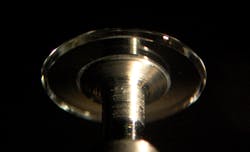LASERS FOR SENSING: WGM microresonator narrows laser-diode linewidth to 200 Hz
Lasers with very long coherence lengths have numerous uses that include lidar, optical communications, interferometry, monitoring smart structures, and, in the mid-infrared (IR), sensing biomolecules. Achieving the narrow spectral linewidth that is required for a long coherence length makes for complicated and expensive lasers, although complexity and size can be somewhat reduced by going with a semiconductor-laser design. Now, engineers at OEwaves (Pasadena, CA) have developed a compact, rugged, production-worthy semiconductor laser with a sub-kilohertz linewidth stabilized with a whispering-gallery-mode (WGM) microresonator.
The 3 mW production model, which is built into a standard butterfly package and has a fiber-optic (either singlemode or polarization-maintaining singlemode) pigtail, contains a commercial laser diode coupled via resonant optical feedback to a high-Q WGM resonator. While standard wavelengths include the telecommunications C- and L-bands (both in the 1550 nm region), the design itself is much more versatile and can be used to create narrow-linewidth lasers with wavelengths ranging from 390 to 2900 nm and, with the use of mid-IR semiconductor sources, much longer wavelengths.
Surface Rayleigh backscattering
The WGM resonator is made of calcium fluoride (CaF2), although magnesium fluoride can also be used (see figure).1 A distributed-feedback laser diode is coupled via a prism to the 2-mm-diameter microresonator, which has an unloaded Q of about 2 × 109, which changes to about 1 × 109 with the prism-coupling. The coupling of the laser to the resonator occurs as a result of surface Rayleigh backscattering in the resonator, leading to injection-locking.
The laser diode and resonator are both mounted to a thermoelectric cooler for wavelength stability, also allowing the laser to be thermally tuned over a 2 nm range. The coupling reduces the laser diode's natural linewidth by a factor of more than 10,000, resulting in an instantaneous linewidth of less than 200 Hz. Long-term drift is less than 10 MHz per day; the laser can be modulated at rates between 0 and 20 MHz with DC coupling and 200 MHz to 1 GHz with AC coupling. The CaF2 crystal is environmentally stable with good thermal and mechanical properties that make it vibrationally insensitive and easy to thermally stabilize, says Lute Maleki, president and CEO of OEwaves. In addition, the laser's monolithic construction makes the entire unit insensitive to vibration.
OEwaves has been producing these lasers for the company's own use in its microwave-photonics products—filters, oscillators, and receivers—for two years. For wider use, OEwaves introduced the laser prototype units at SPIE's Photonics West 2011, which was held in January of this year in San Francisco, CA. The company will have its first production units ready in June.
"A very important feature of this laser is that it offers the same high coherence in spectral regions for which narrow-linewidth lasers do not exist," says Maleki. "This includes the 1064 nm wavelength range, where lasers with a few-kilohertz linewidth currently exist but do not adequately address sensing requirements. Also, other spectral regions such as the 2-to-6-μm region lack availability of narrowline lasers. Here, many sensing applications relating to biochemical molecules will be enabled by the capability this narrowline laser provides."
Next are plans to combine the laser architecture with high-power semiconductor lasers and external amplifiers to offer narrow linewidth at powers competitive with fiber lasers, notes Maleki. OEwaves also intends to produce visible and UV lasers to support applications in spectroscopy, atomic physics, and other emerging applications in these spectral regions.
REFERENCE
1. W. Liang et al., Opt. Lett., 35, 16 (Aug. 15, 2010).

John Wallace | Senior Technical Editor (1998-2022)
John Wallace was with Laser Focus World for nearly 25 years, retiring in late June 2022. He obtained a bachelor's degree in mechanical engineering and physics at Rutgers University and a master's in optical engineering at the University of Rochester. Before becoming an editor, John worked as an engineer at RCA, Exxon, Eastman Kodak, and GCA Corporation.
